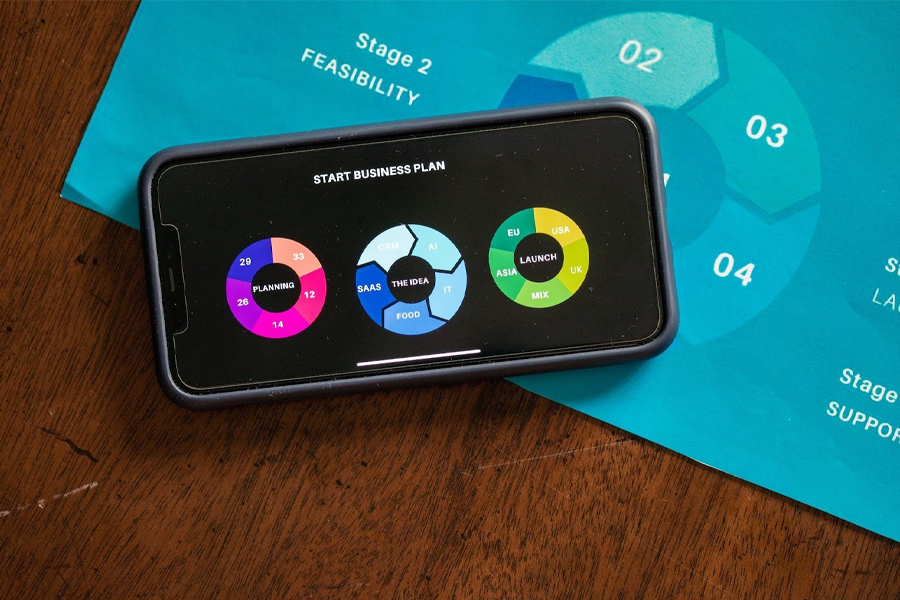Want to know the opportunities available to your business and how to leverage them? A SWOT analysis can help your company uncover not only its strengths and weaknesses but also its opportunities and threats.
In 2015, Value Line conducted an example SWOT analysis for The Coca-Cola Company which determined Coca-Cola’s opportunities, threats, strengths, and weaknesses.
The strengths included Coca-Cola’s global brand name, vast distribution network, and opportunities in emerging markets. Conversely, some noteworthy weaknesses and threats were exchange rate fluctuations, booming interest in healthy beverages, and the rise of healthy beverage providers.
Thanks to this SWOT analysis example, Value Line determined that Coca-Cola would remain competitive, and almost ten years later, this still holds. Moreover, Coca-Cola’s shares jumped by over 60% since that analysis. This tells us that a SWOT framework is a business tool for improvement.
To help businesses conduct their SWOT analyses, we have curated this guide to explain the importance of a SWOT analysis and how to do a SWOT analysis for business efficiently.
What Is a SWOT Analysis?
SWOT analysis focuses on creating an analytical process that helps your business identify threats and overcome weaknesses while leveraging your strengths and opportunities.
SWOT stands for strengths, weaknesses, opportunities, and threats, and its analysis enables you to understand your market before starting a new business initiative. Some business initiatives include revamping internal policies or launching a business.
A good SWOT analysis example is that of a fictional snack company, which unraveled its strengths, weaknesses, opportunities, and threats following the analysis.
After examining internal and external factors, its strengths included sourcing quality raw materials, impressive customer service, and strong supplier communication. Conversely, its weaknesses were a limited product range and heavy supplier dependency.
The snack company identified its opportunities in emerging technology and untapped demographics. It found threats, such as tight competition, a shift towards healthier snack options, and growing concerns about the environmental impact of packaging materials.
The Objective of a SWOT Analysis
The main objective of a SWOT analysis is to help you take advantage of your business’s internal and external factors to make informed business decisions. SWOT analysis was introduced by Albert Humphrey of the Stanford Research Institute to understand why corporate planning consistently failed.
Ever since, the SWOT matrix has become one of the most valuable tools to help you start and grow your companies. Although SWOT analysis offers many benefits, it has one primary objective: helping businesses to come up with data-driven conclusions that drive decision-making and business strategies.

When to Perform a SWOT Analysis
SWOT analysis helps make informed decisions, so perform one before implementing innovative ideas. It would be best to consider factors that matter, such as the opportunities and threats, whether launching a business or revamping internal policies.
Therefore, following a pressing need for a game-changing plan for a business, conduct your own SWOT analysis to see if the company is ready for that action and improve operations as required.
It is high time to see your business as much more than a hobby. With a formal SWOT analysis, you can tap into creative ideas you never had by breaking down the internal versus external factors.
However, SWOT analysis isn’t for only companies; skilled professionals can perform SWOT analysis, and you can do it personally to identify your strengths and weaknesses.
SWOT Analysis Factors
The heart of SWOT analysis covers four compartments that help companies make informed decisions concerning strategy, action, and initiative. These four key factors are generally divided into internal and external factors.
This is usually represented in a SWOT chart or SWOT analysis template with the internal factors placed side by side such that weakness and threat are identified in the same column. As an example, you can see a free SWOT analysis template of a global beverage company with vast distribution but marketing challenges:

Now that you’ve filled out the SWOT template, we will review the internal and external factors that form the analysis.
Internal factors
Strengths (S) and weaknesses (W) refer to internal factors in a SWOT analysis.
Let’s see them below:
- Strengths (S): Strengths are the internal capabilities of a business that give it an advantage over others. These may include a strong brand reputation, skilled workforce, proprietary technology, efficient internal processes, or a loyal customer base.
- Weaknesses (W): Conversely, weaknesses are internal attributes that place a business at a disadvantage relative to others. These include outdated technology, lack of technical expertise, inadequate resources, inefficient processes, or a weak brand presence.
According to the owner of ROYCE New York, Will Bauer, pairing external threats with internal weaknesses can display the most severe weaknesses and threats a company faces.
He says, “After identifying your risk, you can decide whether to eliminate the internal weakness or reduce the external threat by leaving the threatened area and returning to it after strengthening the business.”
External factors
These external factors (opportunities and threats) can significantly influence a company but are not within its control.
More on that below:
- Opportunities (O): Opportunities are external factors a business can capitalize on to achieve its aims. These may include emerging markets, technological advancements, changing consumer trends, strategic partnerships, or competitive gaps. For example, the rising consumer awareness of eco-friendly practices allows eco-friendly fashion brands to capitalize on the demand for environmentally sustainable clothing.
- Threats (T): Threats are external factors that could negatively impact the success of a business. These might include competition, economic downturns, regulatory changes, technological disruptions, or market shifts. For example, the rising interest in healthy beverages could threaten carbonated beverage companies like Coca-Cola.
Developing recommendations based on the result of your SWOT analysis is as essential as conducting it.
Understanding the Purpose of a SWOT Analysis
You can use a SWOT analysis in your business, upcoming projects, or for yourself.
Let’s see the reasons why:
- Simplification: Without a SWOT analysis, things appear more complicated than they are. Information is everywhere, and you can’t determine how they are connected. But SWOT analysis lets you note the most critical data with a bullet, making it digestible.
- External consideration: Without SWOT analysis, a company may not consider external factors for decision-making since it’s easier to identify internal factors than external ones. Thanks to SWOT analysis, a company can uncover factors they may have been afraid to check.
- Cost-effective: Some SWOT reports may not need deep research, external consulting, or training to prepare, making them cost-effective.
Lastly, SWOT analysis can provide organizational, team, project, or individual results. There is no limit to the discovery you can make through a SWOT analysis.
How to Identify Strengths of a Business
In identifying your organization’s strengths, you must determine what you do well and what you do best (USP). Your unique selling should be the first on the list.
The following are more ways to recognize what you do well:
- Evaluate Market Position: Consider your position in the market. Assess market share, customer loyalty, brand awareness, and competitive advantages. A strong market presence like that of Coca-Cola reflects the company’s strengths.
- Review Core Competencies: Aside from the USP, you should list the core competencies of your business that set it apart from emerging competitors. These may include staff specialized skills, patented technologies, or exclusive partnerships.
- Assess Human Resources: Evaluate the workforce’s skills, expertise, and dedication. A highly dedicated, skilled, and motivated team could be among your greatest strengths. Your inputs are usually essential to produce excellent output.
- Examine Operational Efficiency: How efficient are your operational processes? Streamlined operations and effective supply chain management contribute to operational strengths.
You should look out for the areas that bring you a clear advantage. Consider factors yielding the most ROI (Return on investment) for your business.
How to Identify Weaknesses
Similarly to your strengths, you need to identify what you do poorly. Focus on your people, resources, systems, and procedures to find the company’s weaknesses.
This can be done by checking the following:
- Internal Review: Review quarterly documents, reports, and financial statements. This way, you will discover patterns and trends that expose underperforming areas.
- Feedback from Stakeholders: Gather input from various stakeholders, including employees, customers, suppliers, and partners, to get valuable insights into weaknesses, such as poor communication, operational challenges, or product/service shortcomings.
- Competitor Analysis: Analyze competitors to discover where you are lagging. This could include outdated technology, inferior product quality, or ineffective digital marketing strategy.
Lastly, conduct surveys with other team members to understand their perspectives on internal weaknesses. They could be aware of negative factors you may have missed, like organizational culture, leadership problems, or process inefficiencies. That way you can convert weaknesses into strengths.

How to Identify Opportunities for a Business
Identifying business opportunities involves a strategic and systematic approach that you need to follow.
Here are steps you can take to identify them:
- Market Research: Regular market research helps you stay updated on industry trends, customer preferences, and emerging technologies. Aside from that, market research allows you to identify key competitor strategies and customer feedback to find gaps.
- Customer Feedback: Actively seek and analyze feedback from your existing customers to immediately identify any shift in trend. This may uncover opportunities for new products, services, or improvements to your current offerings.
- Industry Networking: Industry conferences, trade shows, and networking events with industry leaders as keynote speakers expose you to emerging opportunities you may have missed.
Also, stay informed about technological advancements relevant to your industry. Embracing new technologies or finding ways to incorporate them into your business model can open up opportunities for innovation and efficiency.
How to Identify Threats to a Business
Identifying threats to a business involves a thorough analysis of internal and external negative elements.
Here are vital steps to help you identify threats:
- Competitive Analysis: Like opportunities, evaluate your existing and potential competitors to highlight their strategies, market share, and strengths. This may help you understand potential threats to your business.
- Market Trends: One thing about consumer behavior shift is that it may affect you negatively, too. Consumer behavior shift could be going in a direction opposed to your brand, leading to extra costs to create awareness and educate people on why they should choose you.
- Economic Conditions: Assess economic conditions that may affect your business, such as American inflation, interest rates, or economic downturns.
- Technological Disruptions: Following Open AI’s announcement of enabling users to create a GPT for any purpose, many other AI companies would have to re-strategize. Otherwise, they would be displaced since Open AI is the biggest market share holder. So, you must identify these possibilities and measure their level of impact.
In addition to that, pay attention to financial threats like cash flow issues, rising costs, or debt. A regular financial analysis will help identify and address financial vulnerabilities.
SWOT Analysis Examples to Consider in The United States
If you’re scoping out your business’ potential in the US, there are some country-specific factors to keep in mind. Let’s take a look at SWOT examples at each step of the planning process.
Strengths
A few examples of strengths: In the United States, a clear strength is the immediate access to some of the latest innovations and new technology. Silicon Valley is a hub for tech startups, research institutions, and numerous networking opportunities.
The education system is also higher in quality on average, meaning that many businesses have access to a competent workforce.
The country is big and is abundant in natural resources such as oil, gas, and renewable energy like solar power and wind.
And of course, the US is infamous for its strong consumer market, where commerce is constantly growing, granting more and more opportunities for businesses.
Weaknesses
There are also some objective weaknesses that affect the local market capabilities.
The ever-so-expensive healthcare system of the US is often considered a challenge, especially for business owners who often can’t cover their employees’ healthcare needs.
On the other hand, the shakey political landscape often leaks into business culture, forcing businesses to take a stance and lose client trust and follow business news daily in order to stay in the loop for current trends.
Opportunities
In general, technological innovation and favorable international trade laws and agreements tend to offer American businesses fantastic growth opportunities both locally and in the global competitive landscape.
Threats
With the change in power often come new regulations and government policies that sometimes put certain companies out of business or significantly hinder their revenue. It’s therefore often necessary to work closely with a law firm that can assist you in finding the right legal position for the business.
Due to high taxation and expensive employee pay, business performance in the US can be threatened by competition that undercuts prices.
Tips for Conducting a Successful SWOT Analysis
In order to conduct a SWOT analysis for your business in the USA, you need to have a few things in mind. Below, we will see them in detail, so read on.

What To Do When Conducting a SWOT Analysis
First, you need to involve external parties in the analysis to help you see things objectively. Get perspectives from employees, suppliers, customers, and partners to identify the primary goal of the SWOT analysis.
After that, create a plan for your SWOT analysis and tie it to your overall business objective. This way, you can compare your strengths or weaknesses to your competitors to identify areas of improvement. Don’t forget to be as realistic as you can during the analysis.
What Not To Do When Conducting a SWOT Analysis
Now that you know what to do when conducting your SWOT analysis, there are also a few things to avoid during the process.
Let’s see them below:
- Don’t avoid relying on assumptions.
- Don’t conduct the analysis alone, especially if there is more than one stakeholder.
- Don’t create a long bullet point for each factor except necessary.
- Don’t be afraid to admit weaknesses.
In addition, don’t use SWOT analysis alone as a strategic planning technique. Involve other strategic planning tools like SOAR (Strengths, Opportunities, Aspirations, Results), TOWS (Threats, Opportunities, Weaknesses, Strengths), or PEST analysis (Political, Economic, Social, Technological).
Applying SWOT Analysis to Decision-Making
Are you planning to conduct a SWOT analysis before starting a significant project or responding to a changing environment? Then, creating a system to tie your analysis to your decision-making is essential.
Taking account of your company’s strengths, weaknesses, opportunities, and threats will positively impact your overall direction.
Here’s how to use a SWOT analysis in making a critical business decision:
- SWOT Analysis table: This is a non-negotiable. Draw a SWOT analysis 2×2 matrix, with four squares representing each factor, making it easier to identify strengths, weaknesses, opportunities, or threats simultaneously. Make your list as concise as possible.
- Specify: Solid decision-making cannot be based on assumptions or generalities. Use succinct and clear terms to describe your strengths, weaknesses, opportunities, and threats targeted to your business strategy.
- Cross-Analysis: Examine the relationships between internal and external factors. For example, how can your strengths help mitigate threats or take advantage of opportunities? Conversely, how can your weaknesses worsen threats or limit your ability to capitalize on opportunities?
- Prioritize and Evaluate: After listing your major strengths, weaknesses, opportunities, and threats, prioritize and tackle the most significant and urgent factors within each category.
- Decision-Making Implications: Analyze how each element of the SWOT analysis relates to the decision. Consider how strengths can be leveraged, weaknesses mitigated, opportunities seized, and threats addressed in the decision-making process.
- Strategy Formulation: Your decisions will inform your strategy, which we will discuss further in the next section. Based on your SWOT analysis and decision, develop strategies that capitalize on strengths, address weaknesses, seize opportunities, and mitigate threats found in your decision.
Following the implementation of your strategies, you should revisit your SWOT analysis after seeing the results. Update the matrix if the results of your swot analysis are poor. Otherwise, it would help if you tweaked it for improvements.

Integrating SWOT Analysis into Your Business Strategy
Creating the SWOT analysis matrix is essential to inform your decision and strategy. Taking another step of prioritization will help you discover how each of the four factors (strengths, weaknesses, opportunities, and threats) overlap. This step is called the TOWS (Threats, Opportunities, Weaknesses, Strengths) analysis.
It is a version of SWOT analysis where you need to consider the external factors before internal factors. It helps formulate strategies by matching inner strengths and weaknesses with external opportunities and threats.
Below is how it works:
- First, identify External Opportunities (O) and Threats (T).
- Identify Internal Strengths (S) and Weaknesses (W).
- Match External Opportunities with Internal Strengths (S-O Strategies): Can you use your strengths to maximize your opportunities?
- Match External Threats with Internal Strengths (S-T Strategies): Can you minimize your threats with your strengths?
- Match External Opportunities with Internal Weaknesses (W-O Strategies): Can you leverage opportunities to reduce your weaknesses?
- Match External Threats with Internal Weaknesses (W-T Strategies): Can you tackle weaknesses to minimize threats?
After identifying strategies, you must implement them and regularly monitor their effectiveness. You should adjust them according to the results or internal and external environment changes.
Frequently Asked Questions
What are four examples of threats in SWOT analysis?
Some examples of threats include your competition and their technologies, economic factors, adverse shifts in consumer behavior, trend shifts, operational costs, regulatory policies, Weather and natural disasters, and heavy dependence on external factors.
What are four examples of opportunities?
Some examples of business opportunities are global market expansion, positive shifts in consumer behavior, remote work solutions, and technology advancements, among others.
What Are the Biggest SWOT Analysis Mistakes?
Not being specific with your lists and making the list unnecessarily long. Additionally, work with unrealistic ideas and do not state your weakness precisely as is. It would be best if you endeavored to be forward-thinking and not rely on SWOT analysis alone.